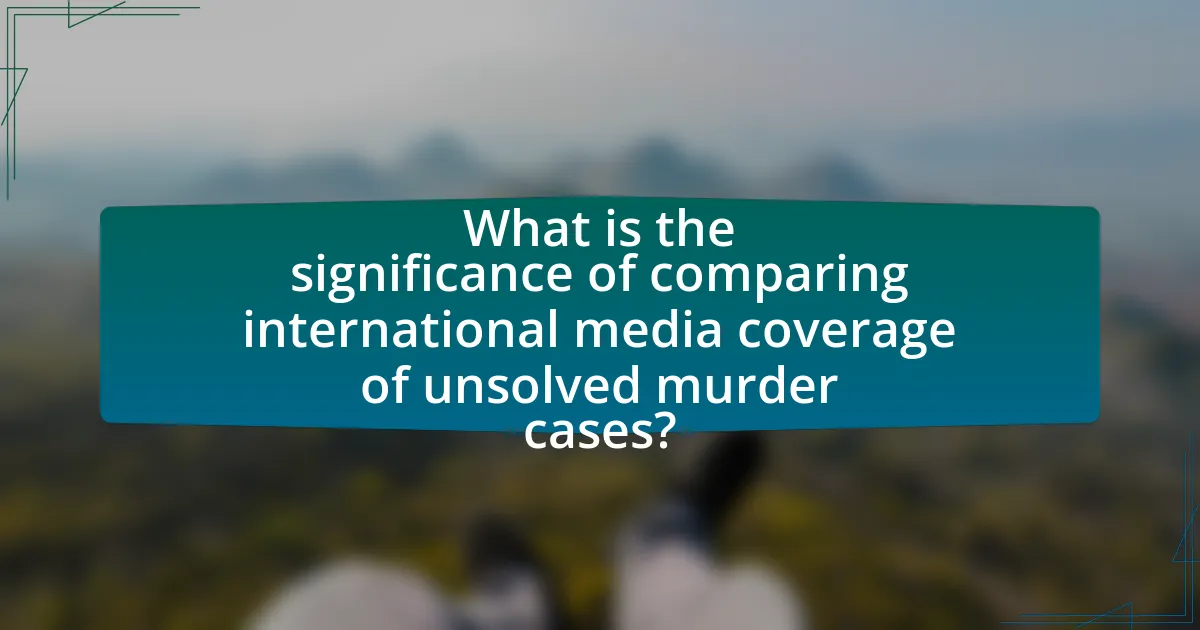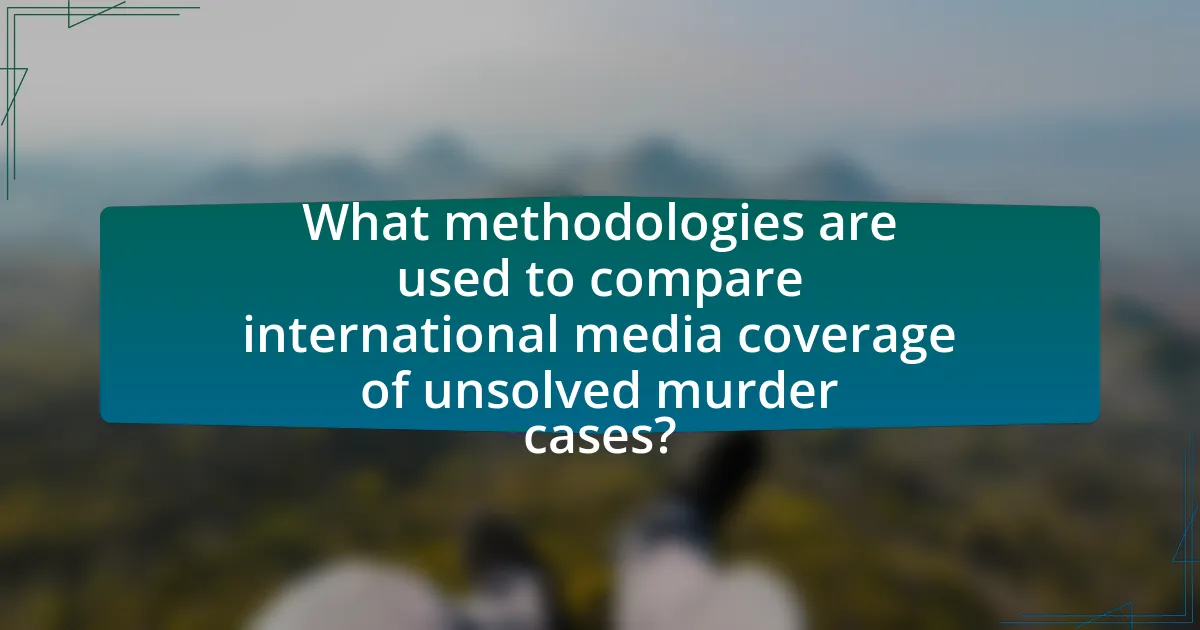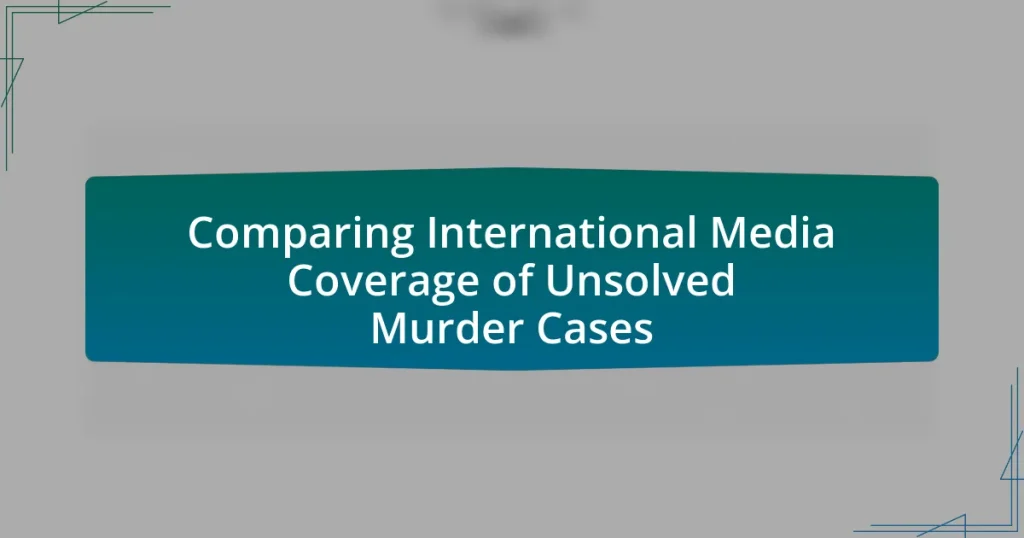The article focuses on the significance of comparing international media coverage of unsolved murder cases, highlighting how cultural, political, and social contexts influence crime reporting and public perception. It examines the impact of media coverage on public awareness, the role of sensationalism, and the portrayal of victims, while also addressing the methodologies used for comparative analysis. Key findings reveal disparities in media attention based on factors such as race and socioeconomic status, and the implications for law enforcement and policymakers are discussed, emphasizing the need for responsible reporting practices to enhance public engagement and support investigations.

What is the significance of comparing international media coverage of unsolved murder cases?
Comparing international media coverage of unsolved murder cases is significant because it reveals how different cultures prioritize crime reporting and public interest. This comparison can highlight disparities in media attention, which may influence public perception and policy responses to crime. For instance, studies have shown that cases receiving extensive media coverage can lead to increased pressure on law enforcement to solve them, while those with minimal coverage may be neglected, affecting the likelihood of resolution. Furthermore, analyzing these differences can uncover biases in reporting based on factors such as race, gender, and socioeconomic status, thereby informing discussions on media ethics and social justice.
How does media coverage influence public perception of unsolved murder cases?
Media coverage significantly shapes public perception of unsolved murder cases by amplifying awareness and influencing emotional responses. When media outlets extensively report on a case, they can create a sense of urgency and concern among the public, often leading to increased pressure on law enforcement to solve the case. Studies have shown that high-profile media coverage can lead to heightened public interest and engagement, as seen in cases like the disappearance of Madeleine McCann, which received extensive international attention and sparked widespread discussion and speculation. This coverage can also lead to the formation of public opinions and theories about the case, sometimes overshadowing factual information. Furthermore, sensationalized reporting can contribute to fear and anxiety within communities, as seen in various instances where unsolved cases are linked to broader societal issues.
What role does sensationalism play in media reporting of these cases?
Sensationalism significantly influences media reporting of unsolved murder cases by prioritizing dramatic narratives over factual accuracy. This approach often leads to exaggerated headlines and emotionally charged language, which can distort public perception and create a sense of urgency or fear. For instance, studies have shown that sensationalized coverage can increase public interest and engagement, but it may also contribute to misinformation and stigmatization of individuals involved in the cases. The impact of sensationalism is evident in how certain cases receive disproportionate media attention, overshadowing other important issues and potentially affecting the investigation process.
How do cultural differences affect the portrayal of unsolved murder cases in the media?
Cultural differences significantly influence the portrayal of unsolved murder cases in the media by shaping narratives, framing, and audience engagement. For instance, in collectivist cultures, media coverage may emphasize community impact and collective mourning, while in individualistic cultures, the focus often shifts to the personal stories of victims and their families. Research indicates that media in countries like Japan often highlight societal implications and moral lessons, whereas American media tends to sensationalize individual stories and investigative details. This divergence in portrayal affects public perception, influencing how communities respond to unsolved cases and the urgency placed on law enforcement efforts.
Why is it important to analyze media coverage across different countries?
Analyzing media coverage across different countries is crucial for understanding how cultural, political, and social contexts shape public perception and narrative around unsolved murder cases. Different countries may prioritize certain aspects of a case based on local values, legal systems, and media practices, which can influence public awareness and response. For instance, a study by the Pew Research Center found that media framing can significantly affect public opinion and policy discussions, highlighting the importance of comparative analysis in revealing biases and gaps in coverage. This analysis can also identify patterns in how similar cases are reported, providing insights into systemic issues within various justice systems globally.
What insights can be gained from comparing media narratives in various regions?
Comparing media narratives in various regions reveals differences in cultural perspectives, societal values, and political influences on crime reporting. For instance, media coverage of unsolved murder cases often reflects local priorities; in some regions, sensationalism may dominate, while in others, a focus on victim advocacy may prevail. This divergence can be evidenced by analyzing case studies, such as the contrasting coverage of the unsolved murder of a young woman in the United States versus similar cases in Europe, where the latter may emphasize systemic issues like gender violence. Such comparisons highlight how regional narratives shape public perception and influence policy responses to crime, demonstrating the significant role of media in framing societal issues.
How does the legal system in different countries impact media coverage of unsolved cases?
The legal system in different countries significantly impacts media coverage of unsolved cases by influencing the flow of information, the level of public access to case details, and the legal restrictions on reporting. In countries with open legal systems, such as the United States, media outlets often have greater access to police reports and court documents, allowing for more comprehensive coverage of unsolved cases. Conversely, in countries with restrictive legal frameworks, like China, media coverage may be limited by government censorship and strict regulations, resulting in less public awareness and discussion of unsolved cases. For instance, a study by the International Press Institute highlights that in authoritarian regimes, journalists face legal repercussions for reporting on sensitive cases, which directly affects the amount and nature of coverage available to the public.

What methodologies are used to compare international media coverage of unsolved murder cases?
Content analysis and comparative analysis are the primary methodologies used to compare international media coverage of unsolved murder cases. Content analysis involves systematically coding and categorizing media reports to identify themes, narratives, and framing techniques across different countries. This method allows researchers to quantify the frequency of specific terms or topics, providing insights into how various cultures prioritize and portray unsolved murder cases. Comparative analysis, on the other hand, examines the differences and similarities in media coverage across different nations, often focusing on factors such as the socio-political context, legal frameworks, and cultural attitudes towards crime and justice. These methodologies are validated by studies that demonstrate variations in media portrayal based on regional differences, such as the work by Hall et al. (1978) on media representation and crime, which highlights how media narratives can shape public perception and policy responses.
How do researchers collect data on media coverage of unsolved murder cases?
Researchers collect data on media coverage of unsolved murder cases through content analysis, which involves systematically reviewing news articles, broadcasts, and online reports. This method allows researchers to quantify the frequency and nature of coverage, including the portrayal of victims and suspects, as well as the framing of the cases. For instance, a study published in the Journal of Criminal Justice examined media coverage of unsolved homicides in various countries, revealing patterns in reporting that highlight differences in public interest and media engagement. By employing coding schemes and qualitative assessments, researchers can draw meaningful conclusions about how media narratives shape public perception and influence investigative efforts.
What types of media sources are typically analyzed in these studies?
Studies comparing international media coverage of unsolved murder cases typically analyze news articles, television broadcasts, online news platforms, and social media posts. These media sources are selected for their ability to reach diverse audiences and provide varying perspectives on the cases. Research indicates that traditional print and broadcast media often frame narratives differently than digital platforms, influencing public perception and engagement with the cases. For instance, a study published in the Journal of Communication examined how different media outlets reported on high-profile unsolved murders, highlighting the disparities in coverage based on the medium used.
How is the reliability of media sources assessed in research?
The reliability of media sources in research is assessed through a combination of criteria including the source’s credibility, accuracy, bias, and the corroboration of information. Credibility is evaluated by examining the reputation of the media outlet, its history of factual reporting, and the expertise of its journalists. Accuracy is determined by cross-referencing facts with multiple independent sources to ensure consistency. Bias is analyzed by identifying the presence of subjective language or selective reporting that may skew the portrayal of events. Corroboration involves checking whether the information presented aligns with data from reputable organizations or academic studies, which can provide a benchmark for validation. For instance, a study published in the Journal of Communication found that media outlets with established editorial standards tend to produce more reliable content, reinforcing the importance of these assessment criteria.
What analytical frameworks are applied to evaluate media coverage?
Analytical frameworks applied to evaluate media coverage include content analysis, framing analysis, and discourse analysis. Content analysis systematically quantifies and analyzes the presence of certain words, themes, or concepts within media texts, allowing researchers to identify patterns in coverage. Framing analysis examines how media outlets present issues, focusing on the angles and narratives emphasized, which can influence public perception. Discourse analysis investigates the language and communication strategies used in media, revealing underlying ideologies and power dynamics. These frameworks are essential for understanding how media coverage shapes narratives around unsolved murder cases across different cultures and contexts.
How do qualitative and quantitative methods differ in analyzing media narratives?
Qualitative and quantitative methods differ significantly in analyzing media narratives by focusing on different aspects of the data. Qualitative methods emphasize understanding the meaning and context behind media narratives, often through content analysis, interviews, or thematic analysis, which allows researchers to explore the nuances and complexities of how unsolved murder cases are portrayed in various media outlets. In contrast, quantitative methods prioritize numerical data and statistical analysis, enabling researchers to measure the frequency of specific themes, words, or representations in media narratives, thus providing a broader overview of trends and patterns across different media sources. For instance, a study might use qualitative analysis to interpret the emotional tone of articles about unsolved murders, while a quantitative approach could count the number of times certain phrases appear in a dataset of articles, revealing how often particular narratives are emphasized.
What metrics are used to measure the impact of media coverage on public awareness?
Metrics used to measure the impact of media coverage on public awareness include reach, engagement, sentiment analysis, and changes in public opinion. Reach quantifies the number of individuals exposed to the media coverage, while engagement assesses interactions such as shares, comments, and likes on social media platforms. Sentiment analysis evaluates the tone of the coverage and public reactions, indicating whether the media portrayal is perceived positively or negatively. Changes in public opinion can be tracked through surveys conducted before and after media coverage, revealing shifts in awareness and attitudes towards the subject matter. These metrics collectively provide a comprehensive understanding of how media coverage influences public awareness.

What are the key findings from studies comparing international media coverage of unsolved murder cases?
Studies comparing international media coverage of unsolved murder cases reveal significant disparities in reporting practices and public engagement. Research indicates that media coverage often varies by cultural context, with some countries emphasizing sensationalism while others focus on investigative journalism. For instance, a study published in the Journal of Criminal Justice found that in the United States, media outlets frequently prioritize cases involving young, white victims, leading to a phenomenon known as “missing white woman syndrome.” Conversely, in countries like Sweden, media coverage tends to be more balanced and focused on systemic issues related to crime. Additionally, studies show that extensive media coverage can influence public perception and pressure law enforcement agencies to act, as evidenced by cases in the UK where public campaigns led to renewed investigations. These findings underscore the role of media in shaping narratives around unsolved murders and highlight the need for responsible reporting practices.
What patterns emerge in media coverage across different countries?
Media coverage of unsolved murder cases reveals distinct patterns across different countries, primarily influenced by cultural, political, and legal contexts. For instance, in the United States, media often emphasizes sensationalism and public interest, leading to extensive coverage of high-profile cases, as seen in the extensive reporting on the JonBenét Ramsey case. In contrast, countries like Japan exhibit a more reserved approach, focusing on factual reporting with less sensationalism, reflecting cultural norms around privacy and respect for victims. Additionally, in countries with strong governmental control over media, such as China, coverage may be limited or censored, prioritizing state narratives over public discourse. These patterns indicate that media coverage is not only a reflection of the crime itself but also of the societal values and regulatory frameworks within each country.
How do media portrayals differ between high-profile and lesser-known cases?
Media portrayals differ significantly between high-profile and lesser-known cases, primarily in terms of coverage volume, narrative framing, and public engagement. High-profile cases often receive extensive media attention, leading to detailed reporting, sensationalism, and a focus on emotional narratives that resonate with the audience. For instance, cases like the murder of Nicole Brown Simpson in the 1990s garnered widespread media coverage, influencing public perception and legal proceedings. In contrast, lesser-known cases typically receive minimal coverage, resulting in sparse reporting that often lacks depth and fails to engage the public. Research indicates that high-profile cases can dominate news cycles, with studies showing that they are covered 10 times more than lesser-known cases, which may only receive brief mentions or be overlooked entirely. This disparity in media attention can affect public awareness and the resources allocated to solving these crimes.
What common themes are identified in the coverage of unsolved murder cases globally?
Common themes identified in the coverage of unsolved murder cases globally include media sensationalism, the portrayal of victims, and the impact of socio-political contexts. Media sensationalism often amplifies the emotional aspects of cases, leading to heightened public interest and pressure on law enforcement. The portrayal of victims frequently emphasizes their backgrounds, which can influence public perception and empathy, as seen in cases like the murder of British student Meredith Kercher, where extensive media coverage highlighted her life and family. Additionally, socio-political contexts, such as systemic issues in law enforcement or societal attitudes towards crime, shape how cases are reported and discussed, as evidenced by the varying coverage of unsolved murders in countries with different legal systems and media freedoms.
What implications do these findings have for law enforcement and policymakers?
The findings on international media coverage of unsolved murder cases imply that law enforcement and policymakers must enhance their communication strategies to effectively engage the public and utilize media as a tool for solving cases. Research indicates that increased media attention can lead to higher public awareness and tips, which are crucial for investigations. For instance, studies show that cases receiving extensive media coverage often see a rise in citizen involvement, leading to potential breakthroughs in solving crimes. Therefore, law enforcement agencies should collaborate with media outlets to ensure accurate and compelling narratives that encourage community participation, while policymakers should consider regulations that promote responsible reporting to avoid sensationalism that could hinder investigations.
How can improved media strategies aid in solving unsolved murder cases?
Improved media strategies can significantly aid in solving unsolved murder cases by enhancing public awareness and engagement. Effective media coverage can disseminate critical information about cases, such as descriptions of suspects or details about the crime, to a wider audience, increasing the likelihood of tips and leads from the public. For instance, the use of social media platforms has been shown to generate substantial community involvement, as evidenced by cases like the 2018 murder of 20-year-old college student, Samantha Josephson, where social media campaigns led to increased public vigilance and tips that assisted law enforcement. Furthermore, strategic partnerships between law enforcement and media outlets can ensure that stories are presented accurately and compellingly, fostering a sense of urgency and encouraging witnesses to come forward.
What role does public engagement play in addressing unsolved murder cases?
Public engagement plays a crucial role in addressing unsolved murder cases by facilitating the dissemination of information and generating leads that law enforcement may not have access to. Engaging the public through media campaigns, social media platforms, and community outreach can increase awareness and encourage individuals with potential information to come forward. For instance, a study by the National Institute of Justice found that public tips can significantly aid investigations, with approximately 15% of cases being solved through community involvement. This highlights the effectiveness of public engagement in generating actionable intelligence that can lead to breakthroughs in unsolved cases.
What best practices can be adopted for responsible media coverage of unsolved murder cases?
Responsible media coverage of unsolved murder cases should prioritize accuracy, sensitivity, and ethical considerations. Media outlets must verify facts before publication to prevent misinformation, as inaccuracies can harm investigations and victim families. Additionally, respecting the privacy of victims and their families is crucial; media should avoid sensationalism that exploits tragedy for viewership. Engaging with law enforcement and legal experts can provide context and ensure that coverage does not interfere with ongoing investigations. Furthermore, adhering to guidelines established by journalism ethics organizations, such as the Society of Professional Journalists, promotes responsible reporting. These practices help maintain public trust and support the integrity of the justice system.
How can journalists balance sensationalism with ethical reporting?
Journalists can balance sensationalism with ethical reporting by adhering to established journalistic standards that prioritize accuracy, context, and the dignity of individuals involved. Ethical reporting requires journalists to verify facts before publication, ensuring that sensational elements do not overshadow the truth. For instance, the Society of Professional Journalists emphasizes the importance of minimizing harm and acting independently, which helps mitigate sensationalism. By focusing on comprehensive storytelling that includes multiple perspectives and factual evidence, journalists can engage audiences without resorting to exaggeration or misleading narratives. This approach not only maintains credibility but also fosters public trust in the media.
What guidelines should media outlets follow to ensure accurate representation of unsolved cases?
Media outlets should adhere to guidelines that prioritize factual accuracy, sensitivity, and ethical reporting when representing unsolved cases. First, they must verify information through multiple credible sources to avoid spreading misinformation, as inaccuracies can mislead the public and hinder investigations. Second, media should respect the privacy of victims’ families and refrain from sensationalizing details that could cause further distress. Third, outlets should provide context about the case, including relevant background information and the status of the investigation, to inform the audience without drawing unfounded conclusions. Finally, they should avoid speculation about suspects or motives, as this can lead to public misperceptions and potentially harm innocent individuals. These guidelines are essential for maintaining journalistic integrity and supporting the ongoing search for justice in unsolved cases.


